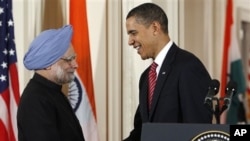The United States and India have a long history of cooperation in science and technology. Beginning with the Indo-US collaborations in agricultural sciences which led to the Green Revolution in India, the two countries have worked together for over five decades in areas such as agricultural and environmental research; health care and immunization against such killers as polio and HIV/AIDS; cybernetics, space exploration, and civil nuclear cooperation.
Most recently, the United States and India have expanded their partnership to accelerate the development and deployment of clean, safe and reliable energy. Such technology could advance economic growth, increase India’s energy independence, and provide enough energy to support the demands of its population of 1.3 billion people.
During Prime Minister Manmohan Singh's visit to Washington in 2009, President Barack Obama and Prime Minister Singh announced the Partnership to Advance Clean Energy, or "PACE". PACE focuses on both research and deployment of innovative clean energy technologies to help accelerate the transition to an energy secure world. More than 14 U.S. Government agencies are actively involved in PACE, supporting joint research centers, mobilizing financing for the construction of solar power plants, increased energy efficient technologies including super energy efficient appliances, and smart grid technologies.
The U.S.-India Energy Partnership expands beyond energy production to the field of high energy nuclear physics. U.S. Deputy Secretary of Energy Daniel Poneman, and Srikumar Banerjee, chairman of the Indian Atomic Energy Commission, signed an agreement in late July that will allow the two countries to work together on basic science research on particle accelerator and particle detector technology.
Particle accelerators smash subatomic particles together, ultimately producing large amounts of energy, creating the conditions in which scientists can test hypotheses on fundamental questions about matter and energy.
Through their collaborative research, U.S. and Indian scientists hope to gain a better understanding of the universe and make important new discoveries that could lead to developments in clean energy technology.
"Working together," said Deputy Secretary Poneman, "we will be able to further our collective understanding of accelerators and high-energy particles, pursue new technologies and scientific discoveries, and advance our shared clean energy goals."
U.S., India Collaborate On Scientific Research

The United States and India have expanded their partnership on the development and deployment of clean, safe and reliable energy.














